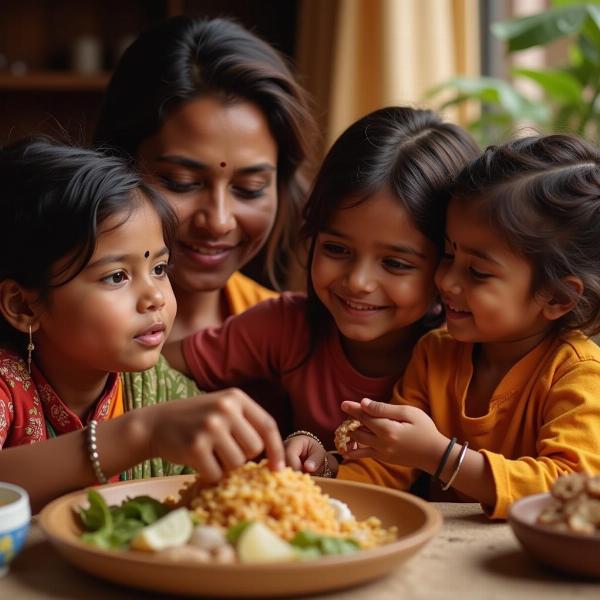Understanding the nuances of “I with you” in Hindi goes beyond simple translation. It delves into the cultural context of togetherness, companionship, and support. This article explores various ways to express this sentiment in Hindi, considering the subtle differences in meaning and usage. Whether you’re learning Hindi or simply curious about expressing solidarity, this guide will provide valuable insights.
Expressing “I With You” in Hindi: Various Nuances
Hindi offers a rich vocabulary to convey the essence of “I with you.” The most direct translation is “मैं तुम्हारे साथ हूँ” (main tumhare saath hoon). This phrase literally means “I am with you” and is widely used in everyday conversations. However, the appropriate choice depends heavily on the context and the relationship between the speakers.
- Formal Context: “मैं आपके साथ हूँ” (main aapke saath hoon) – This version replaces “tumhare” with “aapke,” indicating respect and formality. It’s suitable for addressing elders, superiors, or strangers.
- Informal Context: “मैं तेरे साथ हूँ” (main tere saath hoon) – This form uses “tere” instead of “tumhare,” signifying a close, informal relationship. It’s typically used among friends and family.
- Emphasis on Support: “मैं तुम्हारा साथ दूँगा/दूँगी” (main tumhara saath doonga/doongi) – This translates to “I will support you” or “I will stand by you,” emphasizing commitment and solidarity. The ending changes based on the speaker’s gender (doonga for male, doongi for female).
Beyond Literal Translation: Cultural Contexts
While the literal translations provide a starting point, understanding the cultural nuances adds depth to the expression. In Indian culture, togetherness is highly valued, and “I with you” often implies emotional support, shared experiences, and unwavering loyalty. It’s not merely about physical presence but also about emotional connection.
- Friendship: “यार, मैं तेरे साथ हूँ” (yaar, main tere saath hoon) – Adding “yaar” (friend) reinforces the bond and emphasizes camaraderie.
- Romantic Relationships: “मैं हमेशा तुम्हारे साथ रहूँगा/रहूँगी” (main hamesha tumhare saath rahoonga/rahoongi) – Meaning “I will always be with you,” this expression conveys deep commitment and love.
- Family: “हमेशा तुम्हारे साथ हूँ, बेटा/बेटी” (hamesha tumhare saath hoon, beta/beti) – Addressing someone as “beta” (son) or “beti” (daughter) adds a layer of familial affection and protection.
 Family Togetherness in Hindi
Family Togetherness in Hindi
“I with you meaning in hindi”: Common Questions and Answers
-
What is the most common way to say “I with you” in Hindi?
The most common way is “मैं तुम्हारे साथ हूँ” (main tumhare saath hoon). -
How do I express “I with you” formally in Hindi?
Use “मैं आपके साथ हूँ” (main aapke saath hoon) in formal situations. -
Is there a difference between “saath hoon” and “saath doonga”?
“Saath hoon” means “I am with you,” while “saath doonga” means “I will support you.” -
How do I say “I will always be with you” in Hindi?
You can say “मैं हमेशा तुम्हारे साथ रहूँगा/रहूँगी” (main hamesha tumhare saath rahoonga/rahoongi). -
What are some other ways to express togetherness in Hindi?
Other phrases include “हम साथ हैं” (hum saath hain) – “We are together,” and “एक साथ” (ek saath) – “Together.”
Conclusion: More Than Just Words
Understanding “i with you meaning in hindi” involves grasping the cultural significance of togetherness and choosing the right phrase for the specific context. It’s not just about translating words but conveying emotions and strengthening bonds. By learning these nuances, you can express yourself more effectively and connect with Hindi speakers on a deeper level.
FAQs
- How do you say “Are you with me?” in Hindi? क्या तुम मेरे साथ हो? (Kya tum mere saath ho?)
- Can I use “main tere saath hoon” with elders? No, it’s considered disrespectful. Use “main aapke saath hoon” instead.
- What’s a romantic way to say “I’m with you” in Hindi? मैं हमेशा तुम्हारा साथ दूँगा/दूँगी (Main hamesha tumhara saath doonga/doongi) – I will always be there for you.
- Is “hum saath saath hain” a correct phrase? Yes, it means “we are together.”
- How do you express solidarity with a friend in Hindi? यार, चिंता मत कर, मैं तेरे साथ हूँ (Yaar, chinta mat kar, main tere saath hoon) – Don’t worry, friend, I’m with you.
- What’s the difference between “saath” and “sath”? Both spellings are acceptable and mean “with” or “together.”
- How can I learn more Hindi phrases related to togetherness? Exploring Hindi literature, movies, and music can expose you to more nuanced expressions.
Meaning-Hindi.in is your trusted partner for all your Hindi translation needs. We offer a comprehensive range of services, from business and legal document translation to website localization and educational material translation. Our expert team ensures accuracy, cultural sensitivity, and timely delivery. Need to translate “I with you” in a specific context? Contact us at [email protected] or call us at +91 11-4502-7584. Meaning-Hindi.in is committed to bridging language barriers and fostering clear communication.